Australia Residential Real Estate Market Analysis 2023
Australian house prices continue to rise, albeit at a much slower pace, amidst weakening demand mainly due to rising interest rates.
Nationwide house prices rose by 10.77% (5.2% in real terms) during the year to August 2022, to an average of AU$ 738,321 (US$495,836), according to CoreLogic Australia, down from the previous year’s 20.11% y-o-y increase and the lowest growth recorded since February 2021.
Australia’s house price annual change
The slowdown is more evident in the country’s eight major cities, with the median dwelling price rising by 7.63% y-o-y (2.2% in real terms) to AU$ 808,287 (US$542,824) – the first month of single-digit growth in 16 months.
“The annual trend in housing values is rapidly leveling out,” said CoreLogic.
“Despite the recent weakness, housing values across most regions remain well above pre-COVID levels. Home values in all capital cities and rest-of-state regions, bar Melbourne, remain 15% or above the levels recorded in March 2020, implying most homeowners have a significant equity buffer before their home is likely to be worth less than what they paid,” CoreLogic noted.
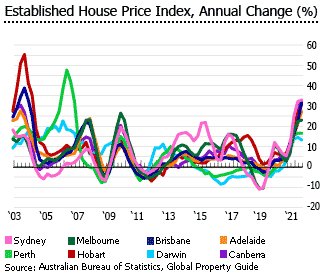
Adelaide saw the biggest annual growth, with its median dwelling price rising by 21.8% during the year to August 2022, followed by Brisbane (17.5%), Canberra (7.8%), Darwin (6.3%), Hobart (5.8%), and Perth (4.9%). In contrast, Sydney and Melbourne saw their dwelling prices fall by 2.5% and 2.1%, respectively.
Sydney has the most expensive housing in the country, with a median price of AU$ 1,066,493 (US$716,007) in August 2022, followed by Canberra with a median price of AU$ 909,748 (US$610,773).
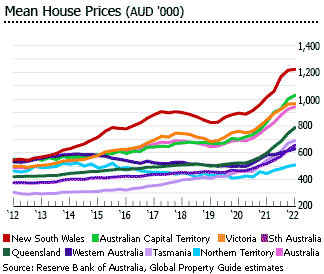
In contrast, Darwin and Perth have the cheapest housing in Australia, with median prices of AU$ 512,531 (US$344,096) and AU$ 561,781 (US$377,160), respectively.
Both demand and supply are falling. In the three months to August 2022, national sales activity dropped 14.8% as compared to the same period last year, with Sydney, Canberra, and Melbourne registering sales declines of 35.4%, 18.9%, and 16.5%, respectively, according to CoreLogic. This was in sharp contrast to 2021’s total dwelling sales which reached 653,000 units – about 40% above the decade’s average and the highest annual sales on record.
“…we are expecting to see less buying activity as higher interest rates and low sentiment continue to weigh on demand,” said CoreLogic. “Should this scenario play out, the net result will be an accumulation of advertised supply that could further weigh down values.”
Dwelling approvals plunged 22% y-o-y to 108,495 units in the first seven months of 2022, in contrast to annual increases of 22.6% in 2021 and 6% in 2020, according to the Australian Bureau of Statistics (ABS).
House prices in Australia surged 52.3% (35.6% inflation-adjusted) from 2011 to 2017. To cool the market and address risks caused by high household debt, the government tightened lending restrictions and imposed higher taxes on housing purchases by foreigners. These measures resulted in a 9% (-11.2% inflation-adjusted) decline in house prices from Q4 2017 to Q2 2019.
When the impact of these market-cooling measures started to wane, the housing market regained its momentum in 2020, with house prices rising by 4.3% (3.5% inflation-adjusted), despite the pandemic. During 2021, house price growth accelerated by a huge 27.5% (23.2% inflation-adjusted).
Australia’s economy grew by 4.7% in 2021, fully offsetting the 2.2% contraction recorded in 2020 during the onset of the Covid-19 pandemic. The economy is expected to grow by another 3.25% this year, buoyed by continued growth in household consumption and a recovery in services exports, according to the Reserve Bank of Australia (RBA).
Housing affordability remains a major problem
Despite the recent house price growth deceleration, Australia, especially its five major metropolitan areas, remains “severely unaffordable” in 2021, according to the 2022 Demographia International Housing Affordability report. The Demographia survey uses the Median Multiple to assess housing affordability in 92 metropolitan markets in Australia, Canada, China (Hong Kong), Ireland, Singapore, New Zealand, the United Kingdom, and the United States.
“Australian markets have a median multiple of 8.0, up from 6.9 two years ago (2019). This is an increase of 1.1 years of median household income. All of five Australia’s major housing markets have been severely unaffordable since the early 2000s,” said the Demographia report.
Sydney was Australia’s least affordable housing market in 2021 and ranked second worst overall, with a Median Multiple of 15.3 – sharply up from the previous year’s 11.8.
“No market except for Hong Kong has reached this level of unaffordability in the 18 years of Demographia reports. Since before the pandemic, Sydney median prices have risen 4.3 years of median household income. This two-year increase alone is nearly equal to the 4.5 years of income required to buy the median-priced Sydney house in 1986,” the Demographia report noted.
Melbourne has a Median Multiple of 12.1, Adelaide with 8.0, Brisbane with 7.4, and Perth with 7.1.
The country’s severe housing unaffordability, especially in Sydney, is partly due to urban consolidation policies which severely limit or even prohibit new housing construction on or beyond the urban fringe.
Demand weakens
Demand is now falling, amidst rising interest rates. In the three months to August 2022, national sales activity dropped 14.8% as compared to the same period last year, with Sydney, Canberra, and Melbourne registering sales declines of 35.4%, 18.9%, and 16.5%, respectively, according to CoreLogic.
This is a sharp turnaround from the total dwelling sales of 653,000 units recorded in 2021, which was about 40% above the decade’s average and the highest annual sales on record.

In the first seven months of 2022, according to figures from the ABS:
- Secondary market: the number of loans for the purchase of existing dwellings fell by 10.6% y-o-y to 172,457 and the value dropped slightly by 0.7% to AU$107.22 billion (US$72 billion).
- Primary market: loans for the purchase of new dwellings by owner-occupiers dropped 30.2% y-o-y to 13,393 while the value of housing finance declined 23.7% to AU$7.76 billion (US$5.2 billion).
Foreign real estate investment remains depressed
The number of approved residential real estate investments by foreigners plunged 37.9% y-o-y to 4,384 in FY 2020-21, amidst the Covid-19 pandemic and the ensuing lockdowns and travel restrictions, based on figures from the Foreign Investment Review Board (FIRB). Likewise, the value of residential real estate investment by foreigners in Australia fell by 39.2% y-o-y to AU$10.4 billion (US$7 billion) over the same period.
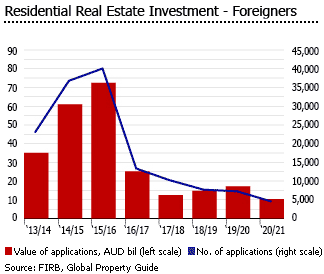
But even before the pandemic, foreign demand for residential real estate has been declining. According to FIRB, this is due to the following factors:
- A tightening of domestic credit and increased restrictions on capital transfers in home countries;
- Increase in state taxes and foreign resident stamp duty
- The introduction of an EC so that only one approval is required for individuals considering a number of residential properties with the intention to purchase only one property, and;
- Foreign investment application fees.
Victoria accounted for the biggest share, attracting about 37% of the total value of residential real estate investment by foreigners in FY 2020-21, followed by Queensland (21% share) and New South Wales (17% share).
In terms of country of origin, the United States accounted for the biggest share, accounting for about 24.2% of the total foreign real estate investment in Australia, followed by Singapore (16.1%), Germany (8.8%), Canada (8.6%), China (7.3%) and South Africa (7.3%).
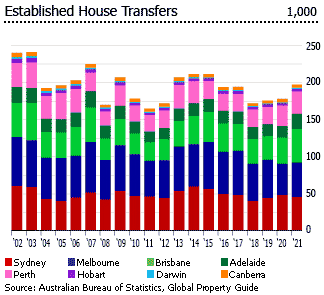
Acquisition of residential real estate by foreign nationals and corporations is subject to FIRB approval. Foreigners are not allowed to buy an established (previously occupied) house. They may buy an unoccupied new dwelling, but only if the FIRB feels that the purchase will not add to the shortage of properties available to native Australians.
Rental yields recovering, and residential rents rising strongly
Rental yields in Australia are gradually recovering, as rental growth outperforms dwelling prices. Gross rental yields for Australia’s capital cities have consistently risen to reach 3.3% in August 2022, after reaching a record low of less than 3% in February, according to CoreLogic.
“While capital city yields are still well below the pre-COVID decade average (4.0%), considering the outlook for lower housing values and higher rents, we could see rental yields returning to around average levels over the next year,” said CoreLogic.
Darwin has the highest rental yield across the country in August 2022, at 5.7% for houses and 7% for apartment units.
In Sydney, yields are moderately low at 2.6% for houses and 3.5% for apartment units.
In August 2022, national rents rose by 10.1% from a year earlier, based on figures from CoreLogic. Over the same period:
- In Sydney, housing rents rose by 9.8% y-o-y while apartment rents were up 11.6%.
- In Melbourne, rents rose by 5.7% for houses and by 12.9% for apartments.
- In Brisbane, housing rents were up by 14.1% and apartment rents increased by 10.7%.
- In Adelaide, rents for houses and apartments rose by 12.2% and 11.1%, respectively.
- In Perth, housing rents rose by 8.7% while apartment rents increased by 7.1%.
- In Hobart, housing rents rose 7% and apartment rents were up 6.9%.
- In Darwin, housing rents rose by 5.3% and apartment rents increased by 5%.
- In Canberra, rents for houses and apartments increased by 8.6% and 7.3%, respectively.
Sydney is the most expensive rental market in the country, with a median house rent of AU$700 (US$471) per week, according to rent.com.au’s August 2022 Rental Market Snapshot. It was followed by Canberra, with a median weekly rent of AU$675 (US$455), and Darwin with a median weekly rent of AU$600 (US$404).
Residential construction activity falling
Dwelling approvals fell by 22% to 108,495 units in the first seven months of 2022 compared to a year ago, in contrast to a 22.4% growth during 2021, according to ABS.
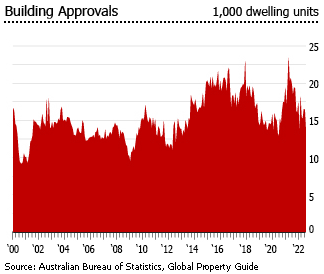
Western Australia registered the biggest decline in dwelling approvals of more than 41% y-o-y in the first seven months of this year, followed by Tasmania (-30%), New South Wales (-25.6%), Queensland (-22.9%), and South Australia (-21%). Dwelling approvals also dropped in Victoria and Northern Territory, by 17.2% and 14.8%, respectively.
Only the Australian Capital Territory saw a y-o-y increase in dwelling approvals of 21.4% over the same period.
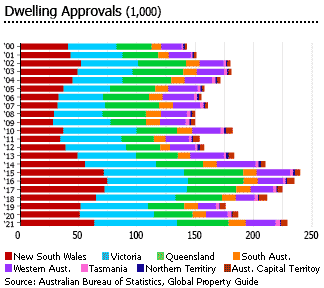
The total number of residential dwellings in Australia is currently at around 10.85 million units, according to the 2021 Census of Population and Housing. About 66% of the total housing stock is owned while 30.6% is rented.
The affordable housing shortage is still a major concern
Australia’s affordable housing shortage continues to worsen, amidst the continued increase in house prices and rents. Before the pandemic, the Australian Housing and Urban Research Institute (AHURI) estimated that there were more than 1.5 million Australian households, or about one in seven households that were in dire need of housing. This shortfall has grown dramatically during the pandemic, though estimates vary considerably.
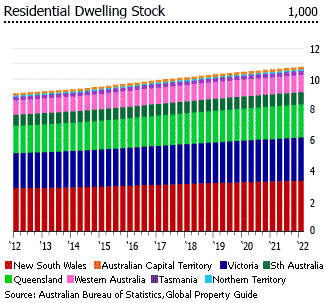
Australia has been under-building residential dwellings, for several reasons:
- Stringent urban planning policies and land use restrictions (called ‘smart growth’, ‘urban containment’, etc.). “An increase in state government zoning regulations is a significant factor driving up the cost of housing,” said Reserve Bank of Australia ex-Governor Glenn Stevens.
- Tax burdens on builders and developers. In New South Wales, government taxes and other charges are estimated to account for about 30% of the price of new houses.
- Due to the extended impact of the global credit crunch, coupled with the economic repercussions brought by the COVID-19 pandemic, some developers continue to struggle to secure finance.
To address the problem, the federal government plans to set up a National Housing Supply and Affordability Council (NHSAC) – a major step towards a long-overdue national housing plan.
The Labor Party, which won the May 2022 elections and secured enough seats to hold an outright majority in the House, also promised to create the AU$10 billion Housing Australia Future Fund and build 30,000 new social and affordable housing units in the next five years:
- 20,000 social housing properties for low-income households – 4,000 of which will be allocated for women and children who are victims of violence and for older women at risk of homelessness;
- 10,000 affordable housing properties for frontline workers;
- AU$200 million for the repair, maintenance, and improvements of housing in remote indigenous communities;
- AU$100 million for crisis and transnational housing options for women and children fleeing violence and for low-income older women at risk of homelessness, and;
- AU$30 million to build more housing and fund specialist services for veterans who are experiencing or at risk of homelessness.
Mortgage interest rates are now rising
The Reserve Bank of Australia (RBA) raised the official cash rate by 50 basis points to 2.35% in September 2022, its fifth consecutive rate hike since May 2022, in an effort to rein in inflationary pressures while sustaining economic growth.
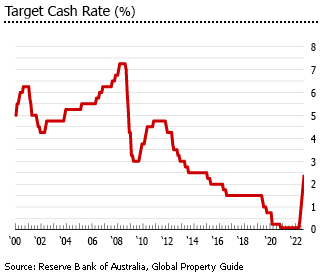
“The Board is committed to returning inflation to the 2–3 percent range over time. It is seeking to do this while keeping the economy on an even keel,” said the RBA. But the central bank recognizes that “the path to achieving this balance is a narrow one and clouded in uncertainty, not least because of global developments.”
As a result, interest rates for housing loans have been rising. In July 2022, the average interest rate for new housing loans was 3.55%, up from 2.39% a year ago. Over the same period:
- Variable-rate new housing loans: 3.51%, up from 2.72% a year earlier
- Interest rate fixation (IRF) of less than or equal to 3 years: 4.1%, sharply up from 1.98% a year ago
- IRF of more than 3 years: 5.06%, more than double the 2.23% a year ago
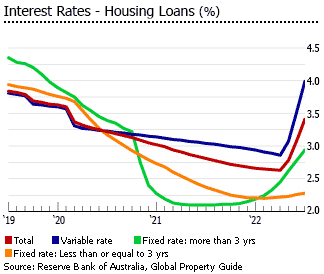
For outstanding loans, the average interest rate increased to 3.41% in July 2022, from 2.81% in the previous year.
- Variable-rate outstanding housing loans: 3.99%, up from 3.04% a year earlier
- Less than or equal to 3-year fixed term: 2.28%, slightly down from 2.37% in the previous year
- More than 3-year fixed term: 2.94%, up from 2.1% a year ago
The mortgage market continues to expand
The Australian mortgage market has grown from around 15% of GDP in the 1970s to more than 93% of GDP in 2021, thanks to low-interest rates.

In July 2022, housing loans for owner-occupiers, which represents real demand, rose by 8.3% y-o-y to AU$1.41 trillion (US$948 billion), according to the RBA. Likewise, housing loans for investors increased by 6.4% to AU$696.9 billion (US$467.3 billion) over the same period.
Tighter lending rules looming
To counter rising risks in home lending, APRA increased banks’ loan serviceability expectations in October 2021. In a letter sent to ADIs, APRA is now expecting that lenders will assess new borrowers’ ability to meet their loan repayments at an interest rate that is at least 3% above the loan’s interest rate, up from the previous 2.5%.
“APRA’s decision, which reflects growing financial stability risks from ADIs’ residential mortgage lending, is supported by other members of the Council of Financial Regulators (CFR), comprising the Reserve Bank of Australia, the Treasury, and the Australian Securities and Investments Commission. In determining its course of action, APRA also consulted with the Australian Competition and Consumer Commission,” reads the APRA’s media release.
This was a turnaround from the earlier expansionary measures introduced. In July 2019, Australian Prudential Regulation Authority (APRA) scrapped its 7% interest rate floor for mortgage serviceability assessments and allowed authorized deposit-taking institutions (ADI) to set their own minimum interest rate floor for use in serviceability assessments and utilize a revised interest rate buffer of at least 2.5% over the loan’s interest rate.
Earlier, the 30% cap on interest-only residential mortgage lending by ADIs was also removed, effective January 1, 2019. The supervisory benchmark was put in place in March 2017, in an effort to cool surging property prices.
In April 2018, the 10% temporary cap on investor credit growth, introduced in December 2014, was also scrapped.
Economic growth to slow; inflation soaring
On an annual basis, Australia’s economy grew by 3.6% in Q2 2022, following y-o-y expansions of 3.3% in Q1 2022, 4.4% in Q4 2021, and 3.9% in Q3 2021, buoyed by strong domestic consumption and exports, according to the ABS. After contracting by a modest 2.2% in 2020, the economy bounced back strongly with a 4.7% growth in 2021.
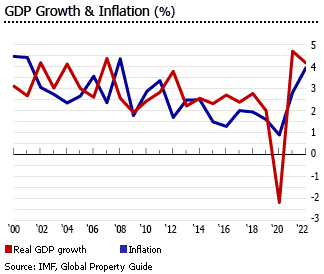
However, due to rising inflation and heightened global economic uncertainty, the International Monetary Fund (IMF) has recently downgraded its 2022 economic growth forecast for Australia to 3.8%, from its earlier estimate of 4.2% growth.
Australia’s trade surplus narrowed sharply to a five-month low of AU$ 8.73 billion (US$5.86 billion) in July 2o22 from the record AU$ 17.13 billion (US$11.5 billion) in the previous month, amidst falling exports, according to figures from the ABS.
The Australian dollar (AUD) has depreciated in the past 20 months, losing about 10% of its value against the US dollar to reach an average exchange rate of AUD 1 = USD 0.6902 in August 2022 from AUD 1 = USD 0.7645 in January 2021. The Australian dollar gained almost 15% against the US dollar in 2020 during the onset of the pandemic, partially offsetting its more than 20% depreciation from January 2018 to March 2020.
The recent weakness of the Australian dollar is partly attributed to concerns about how the ongoing pandemic and the Ukraine crisis will influence China’s economic growth and thus, its demand for Australian commodities, such as iron ore. Also, the US Federal Reserve is aggressively raising interest rates, making the US dollar relatively more attractive than the Australian dollar.
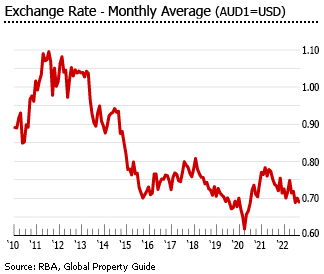
The lower the AUD falls, the more upward pressure it will put on the already surging inflation.
In Q2 2022, the nationwide inflation climbed to 6.1%, up from 5.1% in the previous quarter and the highest level since Q2 2001, amidst surging food and fuel prices, according to the ABS.
Yet, the labor market remains fundamentally strong. The seasonally-adjusted unemployment rate stood at 3.5% in August 2022, down from 4.5% in the previous year and 6.8% two years ago. In fact, it was the second lowest level on record. The number of unemployed people fell to 487,700 in August 2022, a decline of 132,500 from a year earlier.
The labor force participation rate remains high at 66.6% in August 2022 – close to its historic high of 66.8% in June 2022.
Sources:
- Residential Property Price Indexes: Eight Capital Cities (Australian Bureau of Statistics): https://www.abs.gov.au/statistics/economy/price-indexes-and-inflation/residential-property-price-indexes-eight-capital-cities/dec-2021
- Housing downturn accelerates as falling values become more widespread (CoreLogic): https://www.corelogic.com.au/__data/assets/pdf_file/0019/12259/2208-CoreLogic-home-value-index-Sep-22-FINAL.pdf
- Total Value of Dwellings (Australian Bureau of Statistics): https://www.abs.gov.au/statistics/economy/price-indexes-and-inflation/total-value-dwellings/latest-release
- Building Approvals, Australia (Australian Bureau of Statistics): https://www.abs.gov.au/statistics/industry/building-and-construction/building-approvals-australia/latest-release
- Lending Indicators (Australian Bureau of Statistics): https://www.abs.gov.au/statistics/economy/finance/lending-indicators/latest-release
- Rent.com.au rental market snapshot: August 2022 (rent.com.au): https://www.rent.com.au/blog/rental-snapshot-august-2022
- Demographia International Housing Affordability 2022 Edition (Urban Reform Institute; The Frontier Centre for Public Policy): http://www.demographia.com/dhi.pdf
- 2019-20 Annual Report (Foreign Investment Review Board): https://firb.gov.au/sites/firb.gov.au/files/2021-06/FIRB2019-20AnnualReport.pdf
- 2020-21 Annual Report (Foreign Investment Review Board): https://firb.gov.au/sites/firb.gov.au/files/2022-04/FIRB-Annual-Report-2020-21.pdf
- Housing: Census (Australian Bureau of Statistics): https://www.abs.gov.au/statistics/people/housing/housing-census/latest-release
- Australia has been crying out for a national housing plan, and the new council is a big step towards having one (The Conversation): https://theconversation.com/australia-has-been-crying-out-for-a-national-housing-plan-and-new-council-is-a-big-step-towards-having-one-188365
- Can we solve Australia´s housing crisis? Ambitious plan launched to eradicate rental stress and lower homeless rate (ABC News): https://www.abc.net.au/news/2022-08-01/plan-to-solve-housing-crisis/101287662
- Lack of affordable housing set to cost Australia $25b a year (The Sydney Morning Herald): https://www.smh.com.au/national/lack-of-affordable-housing-set-to-cost-australia-25b-a-year-20220621-p5avf2.html
- Statement by Philip Lowe, Governor: Monetary Policy Decision (Reserve Bank of Australia): https://www.rba.gov.au/media-releases/2022/mr-22-28.html
- APRA increases banks’ loan serviceability expectations to counter rising risks in home lending (Australian Prudential Regulation Authority): https://www.apra.gov.au/news-and-publications/apra-increases-banks%E2%80%99-loan-serviceability-expectations-to-counter-rising
- APRA finalizes amendments to guidance on residential mortgage lending (Australian Prudential Regulation Authority): https://www.apra.gov.au/news-and-publications/apra-finalises-amendments-to-guidance-on-residential-mortgage-lending
- Australian National Accounts: National Income, Expenditure, and Product (Australian Bureau of Statistics): https://www.abs.gov.au/statistics/economy/national-accounts/australian-national-accounts-national-income-expenditure-and-product/latest-release
- Australia At a Glance (International Monetary Fund): https://www.imf.org/en/Countries/AUS
- IMF downgrades growth in Australia and across Asia-Pacific (The Sydney Morning Herald): https://www.smh.com.au/politics/federal/imf-downgrades-growth-in-australia-and-across-asia-pacific-20220729-p5b5l3.html
- International Trade in Goods and Services, Australia (Australian Bureau of Statistics): https://www.abs.gov.au/statistics/economy/international-trade/international-trade-goods-and-services-australia/latest-release#:~:text=5368.0%20-%20International%20Trade%20in%20Goods%20and%20Services%2C%20Australia%2C%20May%202020&text=In%20seasonally%20adjusted%20terms%2C%20the,the%20surplus%20in%20April%202020.
- Unemployment rate rises to 3.5% (Australian Bureau of Statistics): https://www.abs.gov.au/media-centre/media-releases/unemployment-rate-rises-35
- Labour Force, Australia (Australian Bureau of Statistics): https://www.abs.gov.au/statistics/labour/employment-and-unemployment/labour-force-australia/latest-release